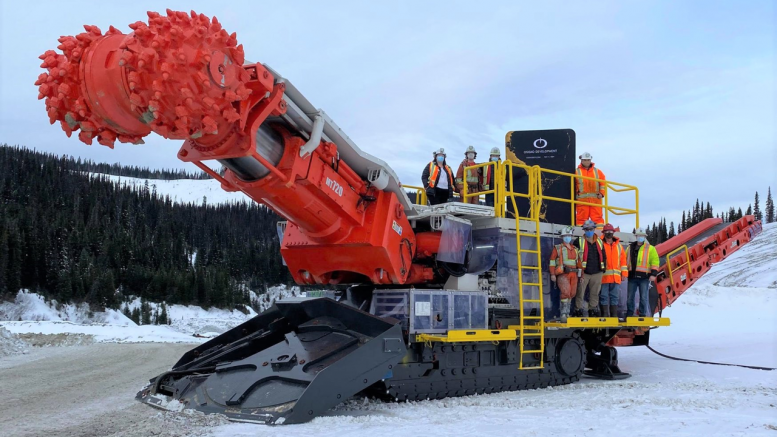Sean Roosen, CEO and chair of Osisko Development (TSXV: ODV; NYSE: ODV) isn’t one to rest on his laurels. A mining celebrity known for the discovery and development of the Canadian Malartic mine that in 2022 produced over 650,000 oz. of gold, Roosen is gearing up for a repeat performance: his new venture, Cariboo Gold. The company is advancing its 100%-owned Cariboo project in central British Columbia, with its environmental assessment certificate expected in the third quarter and its final permit in the first quarter of 2024.
A feasibility study released in January of this year outlined a phased underground development commencing with a 1,500 tonne-per-day operation yielding average annual production of 72,501 oz. of gold, ramping up to 4,900 tonnes per day in 2027 to reach peak annual production of 223,000 oz. of gold. The study cites a capital outlay of $137.3 million for phase one and a further $451.1 million for the phase two expansion.
The project boasts probable reserves of 2 million oz. of gold (in 16.7 million tonnes at 3.78 grams gold per tonne), a measured and indicated resource of 1.6 million oz. (14.7 million tonnes at 3.33 grams gold) and an inferred resource of 1.7 million oz. (15.5 million tonnes at 3.44 grams gold). Those figures are based on more than 700,000 metres of diamond drilling completed by the Osisko group between 2016 and 2021.
Cariboo is anticipated to produce around1.9 million oz. of gold over a 12-year mine life, generating an after-tax net present value of $502 million (using a 5% discount rate) and a 20.7% internal rate of return at a US$1,700 per oz. gold price.
“The average grade of the quartz veins is 11.2 grams per tonne,” said Roosen. “However, when we calculate the grades based on bulk-tonnage mining, we’re somewhere between 3.7 and 4.4 grams gold per tonne for most of the resource, and an average 3.8 grams per tonne in terms of our head grade, which by today’s bulk mining underground standards is quite high.
“We have intercepted the deposit down to a vertical depth of 900 metres, while the average depth of the current resource is only about 350 metres, so there’s still significant potential upside at depth to grow the deposit. Cariboo is a significant gold asset that has the potential to be a tier 1 asset.”
Osisko Development is using several innovative technologies at the Cariboo Gold project. The company has one electric powered Sandvik Roadheader on site for underground tunneling and two more on order to minimize blasting. It’s also using ore sorting technology to separate mineralized rock from unmineralized rock based on density of the material, reducing trucking, waste, tailings, and the consumption of chemicals, power, and water.
“Ore sorting reduces the amount of space we need because a lot of the waste can go back underground as backfill, so we’ve taken every step we can to be a demonstration mine for new technologies,” Roosen said.
The company has also contributed $4.3 million to extend the B.C. Hydro grid to the Cariboo project, ensuring a clean source of power for battery-electric mining equipment and CO2 emission reductions of 22,700 tonnes annually.
In line with its high ESG ambitions, Osisko Development has impact benefit agreements with the Lhtako Dene Nation and the Williams Lake band with whom it is working to restore salmon stocks and to protect and enhance caribou herds in the nearby Cariboo Mountains.
The company’s vision is to aim high to become an intermediate gold miner with multiple operations producing up to 500,000 oz. annually as it also advances its Tintic project in Utah and its San Antonio project in Mexico.
Tintic is another brownfield site, located east of Eureka and 65 km south of the prolific Bingham Canyon copper mine operated by Rio Tinto. It is the second largest metal producing district in Utah after Bingham and is hosted in a similar geological setting. The East Tintic property covers 68.8 sq. km of patented claims and mineral leases previously hosting 23 historic mines.
“All of these deposits are typical end members of a copper-gold porphyry-epithermal district not eroded to the porphyry level,” said Osisko president Chris Lodder. “This really opens up the door to a potential game-changing discovery and we are keen to start drilling the porphyry targets in Q3.”
Currently focused on the past-producing Trixie mine, the company has nearly completed a 5- by 5-metre decline to the first historic mining level, which will replace the existing shaft access and improve underground activities.
Trixie has a measured and indicated resource of 236,000 tonnes grading 28.08 grams gold per tonne and 50.77 grams silver per tonne for contained metal of 213,000 oz. gold and 385,000 oz. silver. There is also an inferred resource of 385,000 tonnes grading 19.64 grams per tonne and 42.82 grams per tonne silver for an additional 243,000 oz. of gold and 530,000 oz. of silver.
Drill results from 42 holes at Trixie reported on May 17 included 62.82 grams per tonne gold over 6.9 metres and 49.11 grams per tonne gold over 1.1 metres.
Osisko’s reputation for new discoveries in historic mining camps was earned at Canadian Malartic and shows no sign of flagging.
“We went to a camp that was in bankruptcy,” recalled Roosen. “Barrick sold it for $1 in 2003. We bought it for $80,000, spent $1 billion to build it and it’s now one of Canada’s largest gold mines and certainly top 10 in the world, producing between 650,000 and 700,000 oz. of gold per year. So, we’ve been around long enough to know what a good asset looks like.”
The preceding Joint-Venture Article is PROMOTED CONTENT sponsored by Osisko Development and produced in cooperation with The Northern Miner. Visit www.osiskodev.com for more information.


Be the first to comment on "JV Article: Clean tech, strong resource nudges Osisko Development’s Cariboo Gold along permit path"